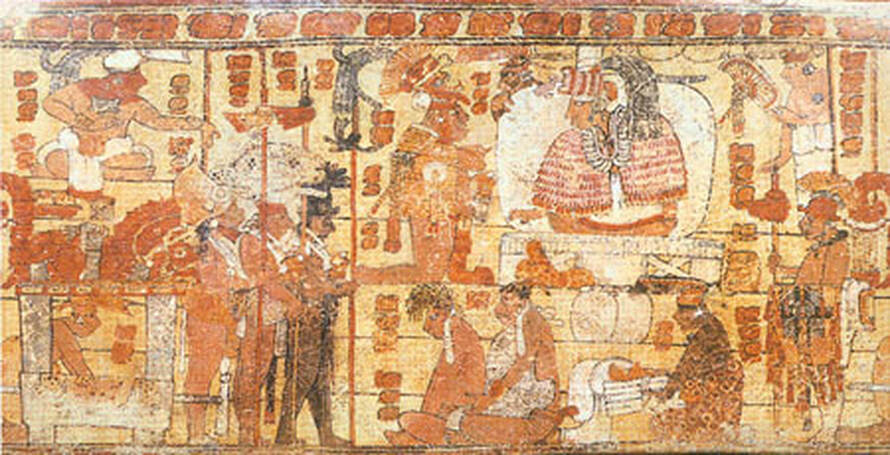MAYA GOVERNMENT
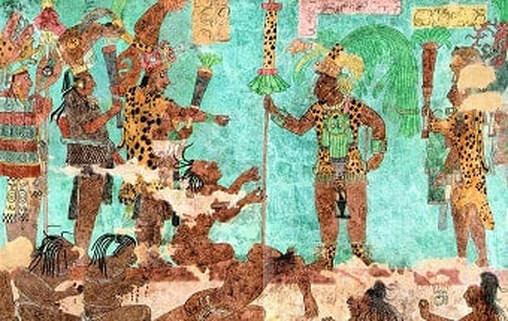
Essential Themes
Government: How do humans organize their societies, and why do they organize them the way they do?
Government: How do humans organize their societies, and why do they organize them the way they do?
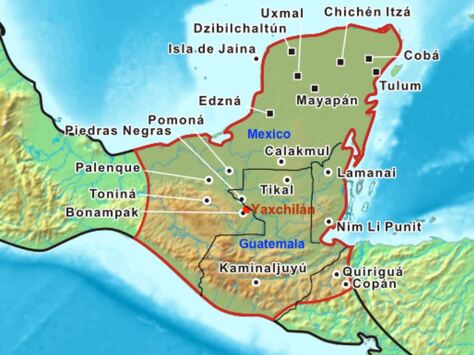 Map with major Maya city-states shown.
Map with major Maya city-states shown.
MAYA GOVERNMENT
The Maya were never a true empire existing under the rule of just one king. Instead, like the ancient Greeks, they were a collection of independent city-states. A city-state consists of a city and the surrounding farmland. Sometimes city-states also include smaller villages nearby.
In what ways were Maya city-states like those found in ancient Greece?
Like the ancient Greeks, Maya city-states were connected through a belief in the same gods, as well as shared religious rituals and myths. Like the Greeks, they also had a common written language and social structure. They even wore the same style of clothing. In fact, like the ancient Greeks, they thought of themselves as one people. However, each city-state had its own king with one noble family in control.
When the ruling noble died, his job stayed in the family. It passed to his son. No one else got a shot at it. A woman could rule if her husband died and left her with a son who was too young to rule, but that situation was rare and usually lasted for only a limited time. The job of ruling - of being king - stayed in one family because the Maya believed that the noble family’s right to rule originated with the Hero Twins. Supposedly, each noble family was a direct descendant of one of the Hero Twins. In other words, the ruling family in each city-state justified their power, authority, and rule by claiming that they were directly related to the gods.
The Maya were never a true empire existing under the rule of just one king. Instead, like the ancient Greeks, they were a collection of independent city-states. A city-state consists of a city and the surrounding farmland. Sometimes city-states also include smaller villages nearby.
In what ways were Maya city-states like those found in ancient Greece?
Like the ancient Greeks, Maya city-states were connected through a belief in the same gods, as well as shared religious rituals and myths. Like the Greeks, they also had a common written language and social structure. They even wore the same style of clothing. In fact, like the ancient Greeks, they thought of themselves as one people. However, each city-state had its own king with one noble family in control.
When the ruling noble died, his job stayed in the family. It passed to his son. No one else got a shot at it. A woman could rule if her husband died and left her with a son who was too young to rule, but that situation was rare and usually lasted for only a limited time. The job of ruling - of being king - stayed in one family because the Maya believed that the noble family’s right to rule originated with the Hero Twins. Supposedly, each noble family was a direct descendant of one of the Hero Twins. In other words, the ruling family in each city-state justified their power, authority, and rule by claiming that they were directly related to the gods.
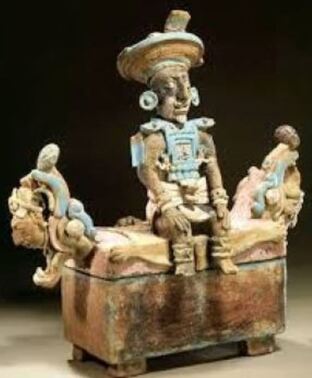 Figurine showing the Kuhul Ajaw seated atop his throne.
Figurine showing the Kuhul Ajaw seated atop his throne.
How did the Maya organize their government?
Before the rise of large Maya cities, it was common for a village to be ruled by one of their elders. As cities grew and Maya life became more complex, however, their government became more complex as well. With more people to govern, more trade to keep track of, and more wars to fight, Maya government took the form of a hierarchy. A hierarchy is a way to organize people or groups so that some are ranked above others according to their status or authority.
As stated before, each city-state had one noble family that ruled. The main leader of each city-state always came from that family and ruled as a king. The Maya name for a member of the ruling class was “Ajaw,” which translates as "Lord." Of course, the most important Ajaw was the king, or "Kuhul Ajaw," the "Divine Lord." As Maya kingdoms grew in size and power, the Kuhul Ajaw needed more and more help to organize and oversee his kingdom. The numerous tasks that helped the kingdom run smoothly fell to the king's council of advisors, also known as the holpop.
Before the rise of large Maya cities, it was common for a village to be ruled by one of their elders. As cities grew and Maya life became more complex, however, their government became more complex as well. With more people to govern, more trade to keep track of, and more wars to fight, Maya government took the form of a hierarchy. A hierarchy is a way to organize people or groups so that some are ranked above others according to their status or authority.
As stated before, each city-state had one noble family that ruled. The main leader of each city-state always came from that family and ruled as a king. The Maya name for a member of the ruling class was “Ajaw,” which translates as "Lord." Of course, the most important Ajaw was the king, or "Kuhul Ajaw," the "Divine Lord." As Maya kingdoms grew in size and power, the Kuhul Ajaw needed more and more help to organize and oversee his kingdom. The numerous tasks that helped the kingdom run smoothly fell to the king's council of advisors, also known as the holpop.
The king’s council also came from the nobility and were appointed to their positions by the king. The two most important holpop members were the High Priest and the Nacom, or Supreme Military Commander. The High Priest was responsible for creating the hierarchy of priests, leading the other priests, and deciding on the dates of ceremonies and festivals. The Supreme Military Commander decided battle strategy and called up troops for war.
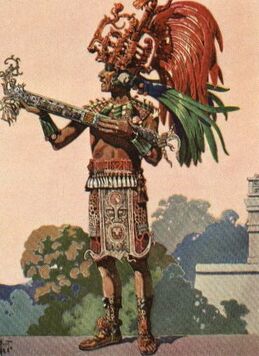
Why were priests especially important to Maya government?
More generally, each of the numerous officials working for the king was a “Batab.” The Batab were responsible for making sure that the city-state ran according to the king's plans. Small towns and villages under the rule of a larger city-state had their own Batab (singular and plural are the same word...). The Batab filled social, religious, and military roles. They were military leaders, overseers, administrators, town councilors, police (tupiles), tax collectors and priests. The Batab were not paid for the work they did, but they did have power within the city, town or village in which they worked for the king.
Because religion was tightly woven into the political structure of the ancient Maya, priests were especially important. Maya priests were said to be gods' slaves and, because the priests could talk to the gods, they had a lot of power over the Maya civilization. Because they could talk to the gods, people were afraid of making the gods unhappy. Of course, Maya kings were considered to be direct descendants of the gods and they ruled by divine right, but the same could easily be said of the priests. As the caretaker of his people, a Maya king was always aware of the potential for upsetting the gods and did all they could to keep the gods happy. They, therefore, depended greatly on the advice of the priests that served them.
More generally, each of the numerous officials working for the king was a “Batab.” The Batab were responsible for making sure that the city-state ran according to the king's plans. Small towns and villages under the rule of a larger city-state had their own Batab (singular and plural are the same word...). The Batab filled social, religious, and military roles. They were military leaders, overseers, administrators, town councilors, police (tupiles), tax collectors and priests. The Batab were not paid for the work they did, but they did have power within the city, town or village in which they worked for the king.
Because religion was tightly woven into the political structure of the ancient Maya, priests were especially important. Maya priests were said to be gods' slaves and, because the priests could talk to the gods, they had a lot of power over the Maya civilization. Because they could talk to the gods, people were afraid of making the gods unhappy. Of course, Maya kings were considered to be direct descendants of the gods and they ruled by divine right, but the same could easily be said of the priests. As the caretaker of his people, a Maya king was always aware of the potential for upsetting the gods and did all they could to keep the gods happy. They, therefore, depended greatly on the advice of the priests that served them.
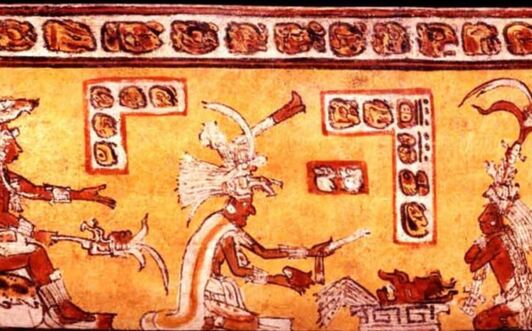 Maya priests and kings worked closely to control their populations. Here you can see the king, seated at left with his hand extended, talking with two of his priests.
Maya priests and kings worked closely to control their populations. Here you can see the king, seated at left with his hand extended, talking with two of his priests.
Priests and kings worked so closely together, in fact, that you could easily say that Maya government would have been impossible without one or the other. The priests had a very big job, and they they played a big role in the success of any Maya city. They controlled the peoples daily lives just like the king. They controlled who should be sacrificed, how much food should be given to the gods, when they should plant crops, who you should marry, etc. Lastly, they also had to make sure that the Maya were doing the right things in the city. They feared that they would be cursed if they had broken the rules.
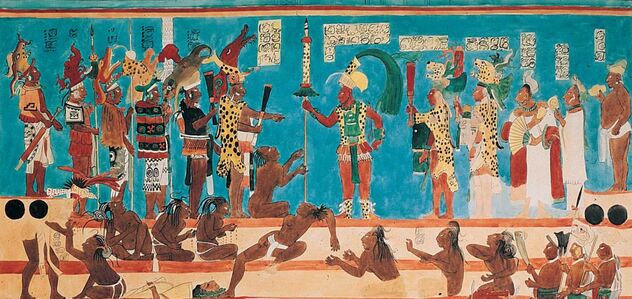 Maya justice was fair but, when found guilty, there were no appeals and punishment was swift.
Maya justice was fair but, when found guilty, there were no appeals and punishment was swift.
Crime and Punishment
The Maya had strict laws and justice was swift for those found guilty of committing crimes. Just as they did in other areas of their civilization, the Maya developed a complex, finely tuned legal system. Accusations of criminal wrongdoing were not taken lightly.
The Maya legal system included judges and trials where evidence was presented. If someone was accused of breaking a law they appeared in court where the local leaders or nobles served as judge. In some cases the king would serve as judge. At the trial, the judge would listen to witnesses and carefully consider all the evidence. Evidence was provided for you and against you. You could help collect evidence that proved you were innocent, just as the other side could collect evidence to prove you were guilty.The Maya did not have prisons, so if the person was found guilty the punishment was carried out immediately.
The Maya had strict laws and justice was swift for those found guilty of committing crimes. Just as they did in other areas of their civilization, the Maya developed a complex, finely tuned legal system. Accusations of criminal wrongdoing were not taken lightly.
The Maya legal system included judges and trials where evidence was presented. If someone was accused of breaking a law they appeared in court where the local leaders or nobles served as judge. In some cases the king would serve as judge. At the trial, the judge would listen to witnesses and carefully consider all the evidence. Evidence was provided for you and against you. You could help collect evidence that proved you were innocent, just as the other side could collect evidence to prove you were guilty.The Maya did not have prisons, so if the person was found guilty the punishment was carried out immediately.
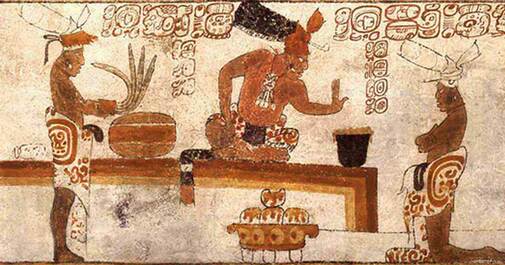 Ultimately, guilt or innocence and the decision about the proper punishment was the king's decision.
Ultimately, guilt or innocence and the decision about the proper punishment was the king's decision.
Punishments varied according to the crime. Many lesser crimes involved fines. Sometimes, all of the property of someone found guilty of a crime was confiscated and auctioned off to pay the fine. If you were found guilty of stealing from someone, you became a captive of your victim and served them as their slave. Another common punishment was to cut the criminal’s hair very short. The Maya took great pride in their appearance and cutting one’s hair short was a way of shaming those found guilty of criminal acts. Until their hair grew out again, everyone who saw them knew they had committed a crime. It was very embarrassing.
Crimes such as murder, arson, and acts against the gods were often punished with death. For those cases, the penalty was usually carried out by strangulation, tossing someone off of a cliff, or by dropping a heavy rock on their head. These were brutal punishments, sure, but also very quick. Even if the punishment was death, however, it could be reduced. If it was determined that the crime was an accident or if the victim of the crime chose to forgive the criminal, the family of the victim had the option of an award in goods or land. Victims could even be awarded an entire family estate, including material goods such as the home and all of its furnishings, as well as the family’s farm animals and fields. Doing so might leave an entire family with no place to live as the result of a guilty verdict against just one member of that family. One result of having such harsh punishments was that crime was relatively rare.
If you need evidence that the Maya system of government worked, just remember that their civilization lasted for 1500 years.
Crimes such as murder, arson, and acts against the gods were often punished with death. For those cases, the penalty was usually carried out by strangulation, tossing someone off of a cliff, or by dropping a heavy rock on their head. These were brutal punishments, sure, but also very quick. Even if the punishment was death, however, it could be reduced. If it was determined that the crime was an accident or if the victim of the crime chose to forgive the criminal, the family of the victim had the option of an award in goods or land. Victims could even be awarded an entire family estate, including material goods such as the home and all of its furnishings, as well as the family’s farm animals and fields. Doing so might leave an entire family with no place to live as the result of a guilty verdict against just one member of that family. One result of having such harsh punishments was that crime was relatively rare.
If you need evidence that the Maya system of government worked, just remember that their civilization lasted for 1500 years.

